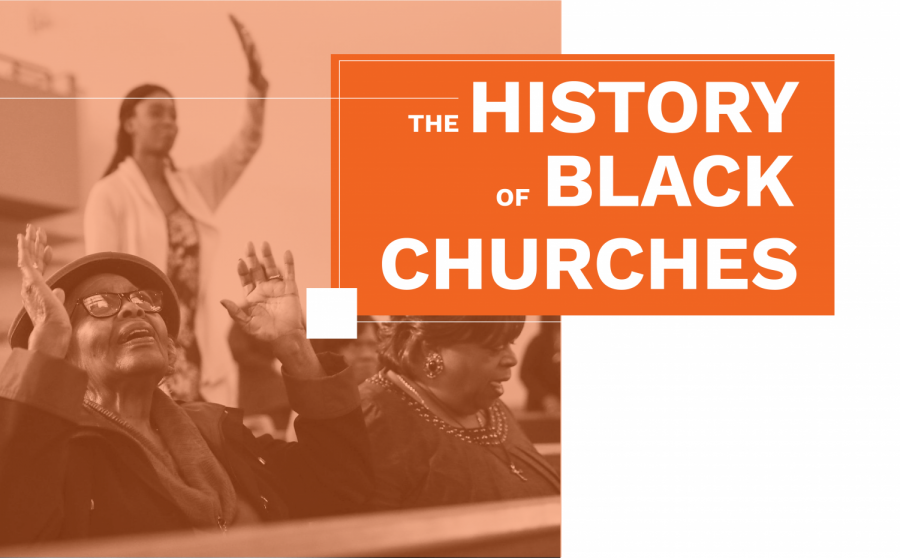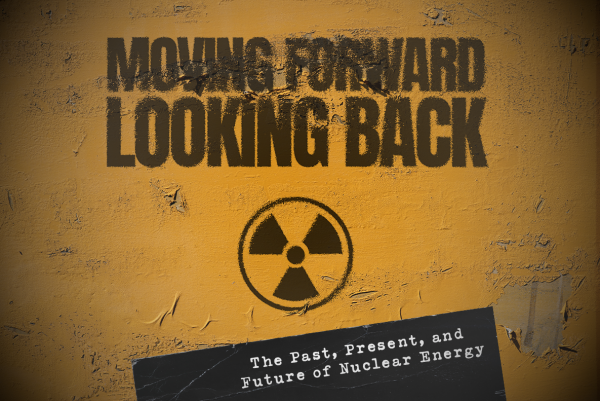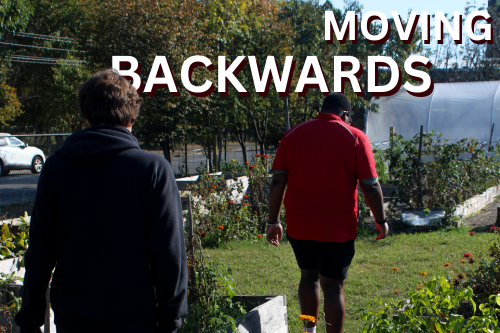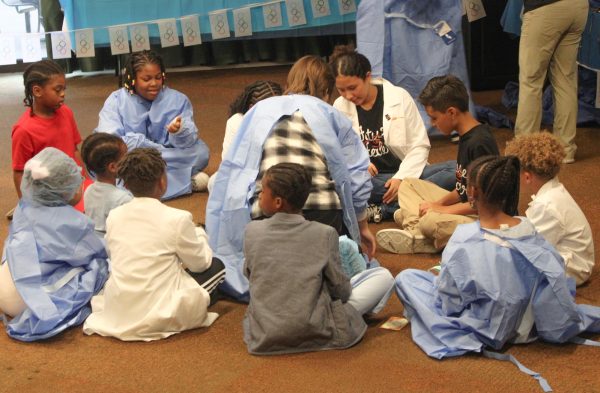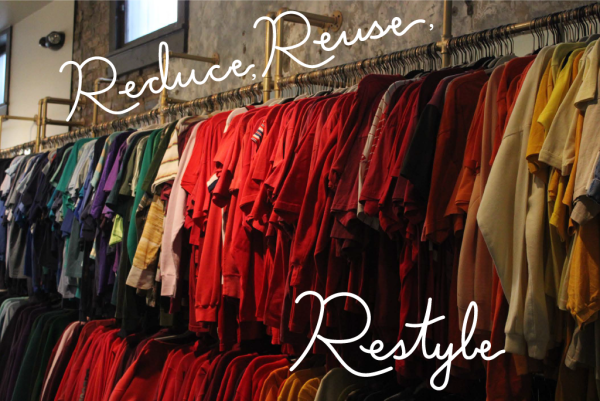BHM: The History of Black Churches
Let’s dive into the history of Black churches in the U.S.
For myself, a member of a predominately white Presbyterian church, my first go at attending St. Stephens Baptist Church, one the most prominent Black churches in Louisville, was somewhat of a culture shock. In the Presbyterian faith, upon entering high school, members go through a confirmation process, to re-establish their childhood baptism. One of the requirements my church puts on confirmands during this period is to visit and attend the services of three or four other churches around Louisville. Kevin Cosby, the main preacher at St. Stephens had been a guest preacher at my own church just weeks before, so I figured it would be the perfect place to visit. St. Stephens, with its wide brick walls covered in glass windows was quite the shift from the old-style, grand architecture I had become accustomed to see from churches I had visited in the past. Despite its unassuming style, the church was anything but unimpressive. Upon pushing through its large glass entrance doors, I was immediately met with boisterous laughter and inclusive hands patting my back welcoming me inside. Looking out into the congregation, rather than the sea of slightly shifted heads and droopy eyes I had become accustomed to, heads were raised to the sky, as hands followed suit and a joyous sway took over the bodies of the crowd in response to the loud, soulful music. In place of soft humms of agreement, congregation members would let out a strong, self-assured “hallelujah!” or “praise the Lord!” My initial jarred feelings were quickly replaced by an appreciation for the evident uplifting spirit of the members. It was incredible to me that such joyous worship had evolved from a long-history of suffering, fueled by centuries of social injustice and oppression. You almost can’t help but be filled with the desire to be a part of this transformative experience. Yet I knew, whether or not I followed suit in raising my head to the sky or let out weak attempts at the same self-assured reactions I had heard moments before, as a white person, I could never truly reach the depths of this experience. So, I became inspired to learn more about Black churches and Black history in general. Whether or not you have been able to experience going to a Black church first hand, chances are you have become familiar with its image. Since the death of George Floyd and rise of the Black Lives Matter movement, it has become ever more plastered across mainstream media, reminding us of what a crucial role they have played in the African American story. Black churches became extremely influential during the Civil Rights Movement, as one of the core – and in some communities the only – institutions run by Black Americans for Black Americans. Despite oppression and ostracism, Black people managed to form a place that was unapologetically theirs and with the vast lack of other institutions like this, it became not only a place of worship, but a center to come together as a community, celebrate culture, and lead the fight for racial justice. Black people have, since the beginning of their history in America, been excluded from involvement in traditionally white societal experiences and hence, many in the search of a place of refuge turned to the community the church had to offer.
What is the Black Church?
The term “Black church” was coined around the ‘50s or ‘60s, acting as a replacement for the outdated “negro church” that was being used to label these institutions. At its introduction, the term never truly resonated with attendees, for most didn’t label themselves as attending a “Black church,” but rather connected themselves to their specific denominations, most commonly Mennonite or Baptist. Although this term has become more applicable and appreciated in today’s landscape, it still undermines how truly decentralized and diverse these communities can be, both in their congregation and beliefs. Today “the black church” is widely understood to include the following seven major Black Protestant denominations: the National Baptist Convention of America, the National Baptist Convention, the African Methodist Episcopal Zion Church, the Progressive National Convention, the African Methodist Episcopal Church, the Christian Methodist Episcopal Church and the Church of God in Christ.
Breaking down the History
During the 1600s, Christianity was split into two main sectors, Catholicism and Protestantism. Protestantism was widely practiced across Great Britain and as time went on, the ideology spread throughout most of Western Europe. As its influence grew, so did the urge to spread the religion to those past Europe’s limited borders. To directly address this desire, Britain and France both began sending missionaries to the Americas with the goal of converting as many natives as possible. Just 116 years later, when the American colonists arrived in Jamestown, Virginia, they had not lost sight of that goal.
Around this time, mass amounts of enslaved persons were being shipped out to the United States though the slave trade and they became the new focus of the colonists’ efforts. Many enslaved persons would be forced to memorize and recite Bible verses, facing brutality if not done to the slave owner’s liking. Due to their lack of education, true conversions through this strategy were difficult and commonly unsuccessful, so slave owners began recruiting and individually converting specific slaves, who were widely trusted throughout their community, to spread Christianity throughout the plantations. Another new strategy slave owners adopted during this time, was bringing their enslaved persons to church. While the slave owners congregated in pews, enslaved persons were confined to the back or balcony. Yet, their distance from the altar couldn’t keep the influence of the church from reaching the minds and souls of enslaved persons. Christianity deeply resonated with the group. Its themes of liberation and “better days coming,” especially in regard to the story of Exodus (the Israelites escape from slavery) left enslaved persons feeling hopeful under the belief that “a righteous God” would provide them the same mercy.
By the late 1700s, enslaved persons longed to have more active roles in church life. In 1780, Andrew Bryan began regularly preaching to a small group of enslaved persons in Savannah, GA. His messages of a loving, righteous Lord were met with multiple whippings from his owner and he was shortly arrested. But the flame he had lit in the enslaved persons’ hearts only grew during his absence and they spread his message to as many as would listen. By 1777, the First African Baptist Church was formed in Savannah, GA.
Freed enslaved persons also began getting involved in the movement during this time. In 1787, Richard Allen and Absalom Jones formed the Free African Baptist Society of Philadelphia, which served as a place to hold services and provide aid and support to newly freed enslaved persons while they became accustomed to their new freedoms. From this institution, they branched out into two independent black-run congregations: the Bethel Church and St. Thomas Episcopal Church.
By 1810, there were 15 African churches representing four denominations in 10 cities, from South Carolina to Massachusetts.
The Second Great Awakening
The early 19th century brought about a worldwide Protestant religious revival known as the Second Great Awakening. A new form of emotional preaching, which included animated facial expressions accompanied by congregation involvement was quickly adopted by many Black preachers. Through the increased spread of Protestant ideals and many new religious reforms, the movement also brought about a great increase in church membership. Despite the religious reforms exponentially taking over the minds and hearts of many around the nation, enslaved persons still lay outside the institutionalized church and therefore were disconnected from the movements of the period. Fearing their safety whilst practicing Christianity, many enslaved persons congregated in “hush harbors,” areas hidden from slave owners, such as swamps, the woods, or ravines. Despite white churchgoer’s attempts to exclude them from the Second Great Awakening, the Black community was experiencing a religious revival of their own, beyond their watchful eyes.
Abolition
The early 1800s brought about an ideal opportunity for the Black church to get involved in the political scene, as the abolitionist movement swept through the country. Frederick Douglas, an extremely significant writer and abolitionist at the time, would commonly point out the hypocrisy of Southern Christians who would “lash up my poor cousin by his two thumbs, and inflict stripes and blows upon his bare back, till the blood streamed to the ground!” while professing a lifestyle of Christian virtue, equality, and acceptance.
As a direct response to the hypocrisy and cruel treatment of enslaved persons at the time, Black ministers joined forces with white abolitionists to form the Underground Railroad, a network of secret routes that guided enslaved persons to free states or Canada. Black churches would commonly serve as safe houses, where escaping enslaved persons could stay and hide. Essentials such as food, water, and blankets would be provided to aid the former enslaved persons on their journey. The Underground Railroad ran from the early to mid 19th century and ended upon the passing of the 13th Constitutional amendment, banning slavery, following the Civil War . It is commonly believed that over 100,000 slaves escaped through the routes.
Reconstruction
Reconstruction (1865-1877), a turbulent period following the Civil War, focused on reintroducing the damaged Confederate states and newly freed enslaved persons into society. On April 11, following his signing of the Emancipation Proclamation, Lincoln delivered a speech setting out his planned Reconstruction efforts, in which he proposed many ideas for new rights which should be granted to freed slaves, the most famous of which, being his promise of “40 acres and a mule” to all newly freed enslaved persons. However, Lincoln was assassinated just three days later and with his death came the loss of all these vows. His plans would be left to Andrew Johnson, who went on to lead the Reconstruction era. Rather than continuing along the path Lincoln had set for him, Johnson went with a much more lenient approach, giving individual states the right to rebuild themselves and make their own decisions regarding rights of newly freed enslaved persons. This ultimately led to the formation of the “black codes” in 1865-66 . These codes were explicitly designed to restrict freed Black peoples’ activity and ensure their availability as a labor force. Following their introduction, many other restrictive laws like it arose. Despite the illusion of freedom being projected at the time, Black people were continuing to be persecuted and held back from incorporation into society.
Despite the overall difficulty the community faced at the time, Black churches, with their great number of newly introduced rights, were thriving. Hush harbors became a thing of the past and Black churchgoers now had the freedom to openly worship and form significant, independent churches of their own, a contrast from the late 18th century, in which independent Black churches had to be kept under wraps and congregations were typically confined to free Black people. This paved the way for the creation of the all-black Shiloh Baptist Church and many others like it during this time. Most former enslaved persons joined independent churches that had been previously formed in the North. These included the African Methodist Episcopal and the African Methodist Episcopal Zion. These churches had the defining characteristic of extremely long, emotional, and poetic sermons introduced during the Second Great Awakening, which reflected the extreme anguish, joy, and twisted emotions surrounding this period. Some Northerners, including Thomas Paine, an English-born political activist, believed this style of worship to be disrespectful and not “true” Christianity, which he believed required proper decorum and focused study of the Bible.
Education
Also during this period, white denominations, including Presbyterian, Congregational and Episcopal, sent missionaries to teach formerly enslaved persons who had been previously denied the right to an education. Over time, increased numbers of newly educated enslaved persons encouraged the establishment of many independent Black institutions of higher education, such as Morehouse College and Spelman College in Atlanta. This growing Black educational movement, like all movements encouraging positive reforms for the Black community, at the time, experienced great backlash.
“The South believed an educated Negro to be a dangerous Negro. And the South was not wholly wrong; for education among all kinds of men always has had, and always will have, an element of danger and revolution, of dissatisfaction and discontent. Nevertheless, men strive to know, ” said W.E.B. Du Bois, American sociologist and civil rights leader, in his book, The Souls of Black Folk.
The fear of white counterparts only encouraged newly freed enslaved persons to hammer on and within a decade education had spread through the community rapidly. With new knowledge and increased understanding came a stronger force of influential civil rights activists, tending to place themselves within the steady, reliable support of the Black church.
The Great Migration
Between 1890 and 1930, 2.5 million Black people, mostly poor and working class, left their homes in the South and relocated in cities of the North, causing an influx of members to join Northern Black churches. In response to the demands of these new congregants, many of which were still attempting to become adjusted to free life and shake off the lasting print centuries of slavery had left on them and their ancestors, Northern Black churches adjusted to a more southern style of worship, incorporating the long emotional sermons, soulful music and themes of hope despite persecution. The churches balanced the responsibilities of being “passionately human, but no less divine,” as Rev. Lacey K. Williams Of Olivet Baptist Church stated in his 1929 Chicago Sunday Tribune published essay.
Olivet developed a multitude of social reforms in attempts to make new congregants feel welcomed and become intertwined in their new communities, while shielding them from inevitable discrimination and persecution. Bible studies, barbecues, and other social events encouraged a sense of community to form between Black people and the churches they attended. Social traditions that were formed during the time remain a tradition in Black churches to this day. The sense of community that was fostered set a bright stage on which immense political and cultural reform would soon occur: the Civil Rights Movement.
The Civil Rights Movement
On Aug. 28, 1955, Emmett Till, a 14 -year-old Black boy, was murdered for allegedly flirting with a white woman. His open casket funeral, broadcasting his brutalized body, shocked millions around the world at the time. A little over four months later, Rosa Parks refused to give up her seat on the bus to a white man in Montgomery, Alabama. This sparked the year-long Montgomery Bus Boycott. As protests began to play out all across the country and Black individuals continued to fight against continued oppression, the Civil Rights movement was born. The Black church’s involvement during this movement was crucial. These churches acted as one of the main sites of community and hope for Black Americans at the time, as it had 100 years prior. Plans were made in their stuffy basements and back rooms, and pastors, who through their work had become extremely talented public speakers, preached the movement’s message to the masses. The institution’s decades of bringing the communities together had paid off and the church acted as the core unifier during the period. Of course, not all churches wanted to get involved. Many were worried in regards to the long-term impacts of these uprisings. Preachers such as J.H. Jackson, leader of the National Baptist Convention, U.S.A., believed that civil disobedience, mass protests, and any other attempts at defying the powerful people of this country and inciting violence would only push progress farther back, opting for a more “people-pleaser” way of getting his ideas through to white people. Yet, most adopted a different mindset, believing that if they continued to sit idly by while injustices occurred, it was a form of acceptance and encouragement, so they pushed on. Tensions finally split the National Baptist Convention, U.S.A., the largest historic Black denomination; King and others broke off to form the Progressive Baptist Convention.
On Aug. 28, 1963, exactly eight years after Emmett Till’s murder, King stood in front of the Lincoln Memorial and went on to give his famous “I Have a Dream” speech, in which he laid out all his hopes for society in the future
“I look to a day when people will not be judged by the color of their skin, but by the content of their character,” he preached.
His speech reached the hearts of masses and was accompanied by a massive march through Washington D.C., with over 250,000 people in attendance. Though it seemed standard for the movement, the joy and success quickly faded, when less than a month later 16th Street Baptist Church, a prominent Black church at the time, was bombed by a white supremacist in Birmingham, killing four young girls and injuring many others.
Due to the church’s large influence and involvement in the movement, it had become the target of much of the opposition’s backlash and endured much violence. The bombing fueled many angry protests and outcries for justice after years of suffering under the current society.
After around two decades of tireless work, Martin Luther King Jr. and many other influential Civil Rights activists of the time came together to witness President Lyndon Johnson’s signing of the Civil Rights Act of 1964. This law guaranteed equal employment and ensured the integration of all public facilities.
The Black Church Today
The Civil Rights movement, despite paving the way for many new and exciting opportunities for the Black community, was accompanied by a multitude of new troubles. As Black Americans became more incorporated into white neighborhoods and white flight occurred as a result, they were once again pushed to the sidelines of society. Poverty and criminalization rates grew exponentially, the existence of African American two-parent homes deteriorated, and a government that was meant to guide them through these crippling issues left them empty-handed time and time again. The Black church got pushed into the political scene, once again, but this time to be assessed. Many began arguing that the church’s once progressive voice had been lost and its essential role in society gone. Others pointed to its remaining members, who claimed that it still held its position as a powerful and reliable refuge. Whether or not the church is the institution it once was, it remains rooted in similar values.
“The church has to address more than just the spiritual needs of Black people. It’s also the socio-political needs, it’s the economic needs, the mental health needs,” said Marshall Jr., lawyer and son of the late Thurgood Marshall, who served as Associate Justice of the United States Supreme Court and an extremely significant voice during the Civil Rights Movement. These ambitions have remained the root of the black church’s strength, since its founding.
This institution has fallen witness to much suffering within its four walls. Despite centuries of fighting, members still face religious discrimination daily, whether it is as direct as it used to be or through microaggressions. Yet, every Sunday, come what may, St, Stephens’ pews and the pews of many like it, such as Lampton Baptist, Bates Memorial, and Zion Baptist, continue to fill with people, standing tall and prideful in the community that they have flourished, praising God’s rich blessings. Whether or not one is religious, Black churches are an incredible visual representation of Black pride and perseverance. From my perspective, these churches will continue rising as one of the most unique, influential, and essential institutions standing with the Black community.
Donations are collected through The Publishers, duPont Manual High School's booster club for J&C. On The Record relies completely on sponsorships, advertisements, and donations to produce and distribute each issue. Please consider donating to our cause, and helping the student journalists of OTR amplify youth voices for years to come.


